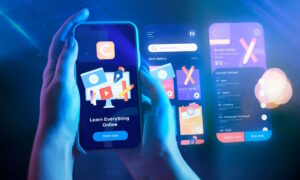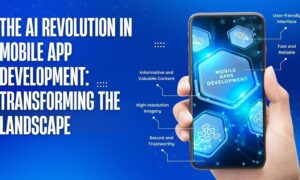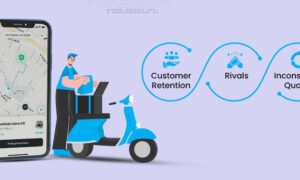By 2027 there will be 7690 million smartphone subscribers in the world. These many smartphone users mean any sort of business not including MOBILE in their operations will be left behind. Mobile does not operate in a vacuum; rather, a series of other innovative technologies are reachable to customers via mobile.
For instance, businesses are using smartphones to bring VR and AR technologies to their customers. Ikea is using AR technology, allowing their customers to test the placement of their furniture without buying.
Mobile is an essential part of our lives today. And its future is even brighter, more important, and beneficial for businesses. As mobile and smartphone technologies grow, the companies must look out for new technologies in this industry. In this article, we will explore the future trends and inclusions of mobile app development.
Evolution of Mobile Applications and their Development
The evolution of mobile is an amazing story of how a small device became an essential part of our lives. Even though the first cellular mobile phone was invented in 1973, the beginning of mobile technology. However, it was not until 1993 that we got to use the first touchscreen mobile phone with built-in applications.
Aren’t you amazed at the timeline here…
- From 1973 to 1993, we were only able to move ahead from a simple non-touchscreen phone to a minimal touchscreen phone.
- But from 1993 to 2022, mobile technology has grown exponentially so that we can conduct millions of worth of transactions through mobile securely.
With IBM’s Simon released in 1993, the next milestone was Blackberry’s 5810 launching in 2002. From this Blackberry phone, users were able to send wireless emails. This mobile here set the stage for rapid and unprecedented mobile app development and its related technologies.
From that day, Java has become and remains an important development technology for mobile applications. When Google and Apple launched their application stores in 2008, people could download applications.
From 2008 till 2021, a total of 230 billion first-time mobile app downloads from Apple and Android devices were made.
Today, we have a mobile application for everything, and we mean literally everything. From entertainment to games, to study, finance, communication, management, tracking, and whatnot.
Mobile applications have achieved these many milestones because of the technologies used for their creation. Evolution is remarkable, but the advancement in these applications and how they function is credited to the emergence of new technologies. From Edge to 3G and now 5G and several other technologies, let’s see how these mobile app development technologies and trends are beneficial.
Future Trends of Mobile App Development
Mobile applications are developed faster than ever today. The reason? To meet the growing demand for new content. Companies, businesses, and end-users are hungry for more, which challenges and inspires mobile app development companies to innovate and accelerate their development systems.
Inclusion of 5G
The Fifth Generation mobile network, or 5G, is an enabler technology that has the potential to radicalize how people use mobile applications. One of the core benefits of this technology is that it will substantially reduce latency and enhance data-sharing speed capabilities.
With 5G, mobile applications can perform exceptionally faster, encouraging sharing of massive amounts of data in a jiffy. As we move ahead, the speed of online transactions will matter a lot.
When 5G is fully integrated and implemented, we can bring the true potential of cloud technology to mainstream mobile connectivity. This is going to open up new avenues of application development and their efficiency.
However, the integration of 5G will also challenge mobile app developers to create relevant applications. These new applications must have the architecture to handle tremendous amounts of data speed. It’s a fact that companies that will take the step to move in this direction first will have the first-mover advantage.
AI and ML
Artificial intelligence and Machine Learning have to be on every list that talks about advanced and future technologies. These two technologies have the potential to create automated machines (which are already present) and help humans understand data like they have never done before.
In mobile applications development, AI and ML are the key forces of change and have multiple use cases and applications. These include facial detection, chatbots, machine-controlled communication, recommendation engines, speech recognition, financial forecasting, predictive maintenance, text prediction, and much more.
All these functions have become possible with AI and ML’s integration into our mobiles. If we are doing all this today, imagine the impact AI and ML can have on our lives, businesses, and transactions in the future. With more advancement, we can expect self-driving AI technology getting more to people.
Blockchain
Blockchain doesn’t only mean bitcoin and cryptocurrencies. Rather, these are use cases of the blockchain technology. In essence, blockchain technology is a structural approach to recording transactions in blocks. A chain of these blocks is connected through peer-to-peer nodes.
Although, at present, blockchain technology is mostly used in cryptocurrencies and related platforms, it will extend to other areas in the future. Going forward, blockchain’s two primary aspects, digital assets and securing identities, will find their way into other industries as well.
Banks can use this technology to build mobile wallet applications to ensure faster and more secure transactions. Moreover, in the future, we can also see the merger of blockchain, AI, smart contracts, and IoT technologies to create more efficient use cases. Shipping and logistics companies can also use this technology to bring down their operational costs and eliminate inefficiencies.
Wearables
Wearables include digital devices we can wear, including earbuds, watches, etc. Mobile applications can play a crucial role here in improving how we interact with wearable technology. Going forward, the wearables will get more sophisticated and can have better features also.
So, we will need better mobile applications accustomed to these wearables. At present, the world has more than 1 billion connected wearable devices, and this number will only grow. However, at present, consumer electronics take a major chunk of the wearables.
But we are expecting the wearables to be used more frequently in other industries, especially healthcare and security. Apple has already teamed up with Schlage (lock manufacturer) to create smart locks and applications for smart locks.
Integration of AR and VR
Although AR and VR have been around for a while, they still have a lot of potential to grow. Out of these two, virtual reality has seen better growth and integration into mainstream industries. Companies are already using AR and VR-enabled applications to drive better engagement.
Some great examples of AR and VR include the Pokemon Go game or when healthcare institutions are using augmented reality techniques to teach and train. Furthermore, going ahead, we will see applications integrated with AR and VR technologies to improve the user experience further.
Better Security
The fact that we can find almost anyone and everyone on the web means that we are already living in a vulnerable world. And as more applications are launched, they will also extract more information, which can increase the risk factor.
In the previous points, we have talked about an increasing number of applications recording personal information. Smart locks and applications will have our fingerprints, and AR and VR-enabled apps will have access to our homes.
So, with these, the concerns users have today are not unfounded. A study by Synopsys revealed that 63% of Android applications have security vulnerabilities. Plus, there might be a 500% increase in mobile cyberattacks as hackers try to steal passwords and bank details.
Due to this, we can expect better security systems in our phones and applications to support this system. An increase in biometric authentication and facial or eye recognition is expected. In addition to this, the usage of distributed ledger technology (DLT) will also become more prevalent.
IoT
The Internet of Things allows us to build an ecosystem of connected devices. This web of connected devices interacts and communicates with each other without any breaks. The ability to control lights, appliances, curtains, etc., is an example of the IoT network.
We are already at the nascent stage of home internet-connected systems and devices. IoT has given way for Smart Home Technology to take its shape; however, there is still a lot of work to be done here.
Moving forward, customers are expecting to see more connected devices and applications to control these devices. As a result, we can see applications that can completely control how a device operates. We can get its status report on their phone and even predict malfunctions.
These mobile application trends are going to redefine how people interact with the digital environment. The integration of these technologies will make us smarter, more efficient, and quicker.
How Must Developers Progress with the Mobile App Evolution?
New technologies will continue to come ahead with time. However, these technologies cannot reach the end user directly. They need a medium, and one of these mediums is mobile applications.
The onus of understanding these technologies and how they can be forwarded to the common man is on mobile app developers. So, with technology’s advancement, mobile app developers are also supposed to learn and grow. They need to become better at ideating, designing, and developing applications.
From day one, software developers have the job of continuously evolving and becoming better at their job. One of the ways to build better solutions and keep abreast with the latest technologies is to learn about them first-hand. The first time a developer tried to integrate VR technology into an application must have first learned about how it works.
Similarly, developers need to learn about these technologies and understand their architecture. With this understanding, they can build applications around these technologies and bring benefits to the customers.
Developers can also network with like-minded individuals or join communities like Recro to learn about the latest technologies.
Conclusion
Mobile application development is about creating solutions that can change the way an individual transacts, communicates, and entertains. As we are progressing into a digitized world, the usage of mobile and mobile applications will increase.
The addition of new technologies makes these applications better in terms of how they benefit the end users. New technologies also add new use cases, which means better experiences for the users.



































